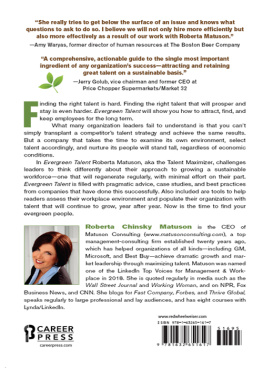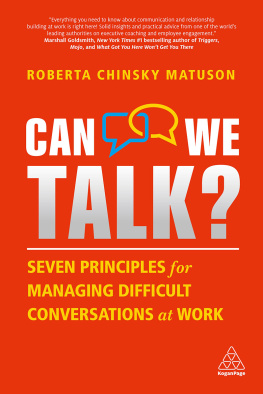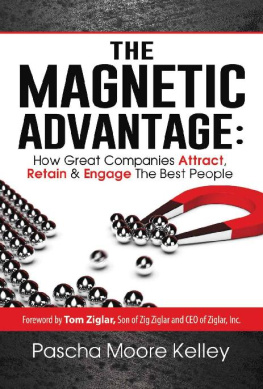Chapter 1
The Magnetic Leader
Ive asked dozens of people to tell me what comes to mind when they hear the words magnetic leader, and no two responses have been exactly the same. Some people say, Ill know one when I see one, which isnt all that helpful, considering we cant get into the minds of those responding! Heres my definition: a magnetic leader is someone whose leadership style is irresistible. You cant help but be attracted to this person and want to be on her team.
As Im writing this, I happen to be flying over the Grand Canyon. As I look out of the plane window, Im reminded of the huge chasms one finds in the leadership of organizations. There are leaders who are deep thinkers and who encourage others to look out over the horizon and enjoy the journey, while others simply blaze their own trail and expect that employees will fall in line. The first kind of leaders have given careful consideration to what it means to be responsible for the success or failure of those they lead. They charge ahead every day with the intent of helping their people chart their own course to personal and business success. They seek to work with like-minded people, and, as a management team, they demonstrate high levels of leadership in everything they do.
To help us fully comprehend what it takes to achieve magnetic leadership status, lets deconstruct the makeup of these different types of leaders. As we do this, you will gain a better sense of what it takes to achieve similar levels of success and can adjust your behaviors accordingly.
Traits of the Magnetic Leader
Lots of leaders think they are magnetic, when in fact they are anything but. Here are seven traits that are common among magnetic leaders, as well as examples of people who personify (or personified) these qualities. Im sure you can think of a dozen more traits that would fit into , well go into more detail regarding the way these characteristics impact stickiness. Ill also suggest ways to acquire or fine-tune your magnetism. I encourage you to explore all of these methods and to focus on the two or three attributes that are the most meaningful to you.
- Authenticity. Magnetic leaders dont try to be someone else, nor do they change who they are based on office politics. They are true to themselves and are honest in their dealings with others. They are not afraid to share their mistakes or shortcomings. Warren Buffet is an authentic leader who speaks openly about his $200 billion mistake buying Berkshire Hathaway.
- Selflessness. Nelson Mandela immediately comes to mind when I think about inspirational leaders who are selfless. Leadership is a service business, and service comes with sacrifice. Mandela made many sacrifices so that others could advance, including giving up power. When elected president of South Africa, he refused to serve more than one term because he believed that a swift transfer of his authority was in the best interest of post-apartheid South Africa.
- Strong communication. Magnetic leaders communicate frequently and clearly. They speak their minds, even if it makes them unpopular. When they are forthright with their opinions, such people often become even more magnetic. Pope Francis is a great example of an outspoken leader with strong communication skills, and his popularity has risen tenfold, as have donations to the church. People around the world are embracing Pope Francis. He doesnt toe the party line. He says whats on his mind, which is refreshing.
- Charisma. They have a charm that inspires devotion. No matter where people fall on the political spectrum, most would agree that former President Bill Clinton possesses great charisma.
- Transparency. Leaders who are transparent are consistently honest and open in their communicationso much so that people never have to guess what these leaders really mean when they say something. This level of openness often spreads to the wider company culture. Tony Hsieh, CEO of Zappos, is the first person who comes to mind when I think of transparent leaders. From the very beginning, before blogs became all the rage, Hsieh would openly share the happenings (both the good and the bad) at Zappos for both employees and customers to see. In fact, the companys all-staff meetings were broadcast on the Internet.
- Vision. Vision and magnetism go hand in hand. Visionary leaders, like the late Steve Jobs, are the dreamers who make us realize that anything is possible. They have a vivid imagination that inspires others to get on board and come along for the ride.
- Resilience. Magnetic leaders understand that there will be times when things wont go according to plan. You simply must keep charging ahead, often course-correcting as you go. No one knows this better than GM chair and CEO Mary Barra, who had an incredibly stressful first year in office. She faced revelations about faulty ignition switches, a 30-million-car recall, and pressure from investors to return more cash to shareholders. But two years into her tenure, GMs financial health has rarely been stronger.
As you can see from this list, magnetism isnt something you are either born with or not. Its a state of leadership that evolves over time. The key word here is evolves, as most of the magnetic leaders Ive interviewed for this book were like many of you when they first started out. They wanted to be good leaders and were willing to put in the work needed to reach that goal. They observed other leaders. Some, they emulated; others, they promised they would not be like. They learned by doing and made course corrections along the way. Many were fortunate enough to have a mentor who gave them honest feedback. Others hired coaches at different times in their careers. All of these leaders invested in their own development, and they continue to work on improving themselves every day. They do so because they understand the power of magnetism and how it can be a game changer when it comes to attracting employees, customers, and profits.
A common theme among the magnetic leaders I interviewed for this book is their willingness to be open about their failures. For example, Rob Nixon, CEO of PANALITIX, a membership community for accountants, told me that his inspiration to change his leadership style and the culture of the organization came from his worst people year, which took place in 2010. I had twenty-six people movements in a team of sixteen, Nixon said. Not good. This jolt led him to consider the type of organization he wanted to create. He wrote down the type of culture he wanted for his business, basing the culture on the values and standards important to him. He then posted the blueprint for his company culture on his website so that employees and customers could see what his firm stands for. Nixon is glad his worst people years are behind him, although, like any good leader, hell admit that he is a work in progress.
The Power of Magnetic Leadership
If you are going to put in the work to become a magnetic leader, then you probably want to know up front what kind of ROI you can expect. After reading this section, you will no doubt agree that the return on magnetism (ROM) is significant and well worth the investment.
Better Hires, Faster
Retired Biogen CIO Raymond Pawlicki was able to quickly differentiate himself from other CIOs through magnetism. Over the years, Pawlicki worked really hard to build a following. He made it a point to spend a good deal of his time out of the office. He made a name for himself and the company he worked for. He did so by volunteering to speak at conferences, visiting college campuses, and meeting with anyone who asked him for a few minutes of his time. Whenever Pawlicki had a job opening in his department (and it was rare), he had a line of people waiting outside his door hoping hed hire them. He shared with me that he had rarely paid a recruitment fee to an employment agency during his long careersomething most of his peers could not say.

![Roberta Chinsky Matuson [Roberta Chinsky Matuson] The Magnetic Leader](/uploads/posts/book/124043/thumbs/roberta-chinsky-matuson-roberta-chinsky-matuson.jpg)







